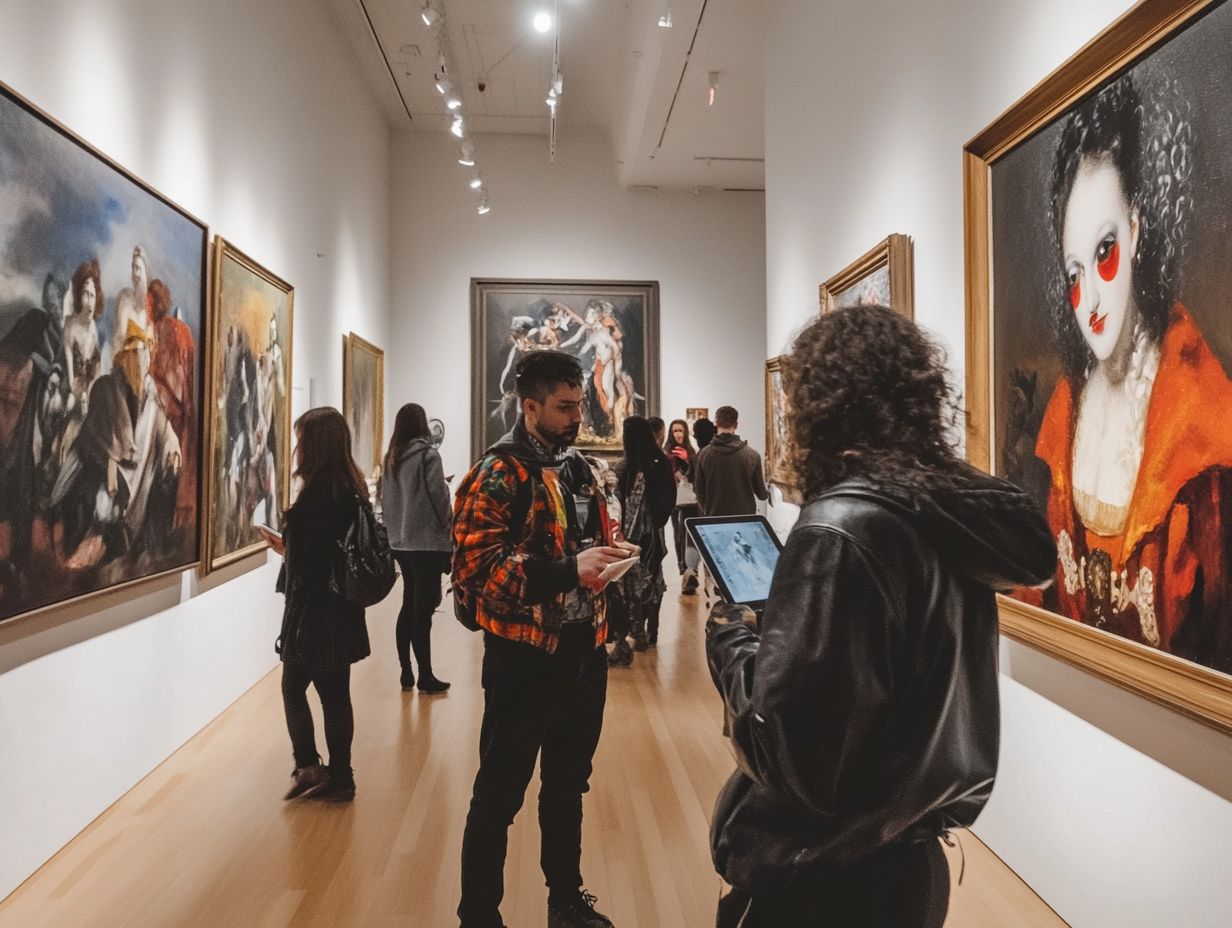The Intersection of Art and Technology
The intersection of art and technology is a dynamic realm where creativity meets innovation, shaping how you perceive and interact with both.
This article delves into the historical evolution of these two fields and explores their intertwined nature over time. You ll find insights into current trends that highlight new collaborative forms, assess the impacts of technology on artistic expression, and discover how art drives technological advancements.
We will also tackle the ethical challenges and controversies that emerge in this fascinating interplay. Join us as we unravel the complexities and celebrate the synergy between art and technology.
Contents
- Key Takeaways:
- Historical Perspective
- Current Trends
- The Impact of Technology on Art
- The Impact of Art on Technology
- Challenges and Controversies
- Frequently Asked Questions
- Why does ‘The Intersection of Art and Technology’ matter to you?
- How has technology impacted the art world?
- What are some examples of ‘The Intersection of Art and Technology’?
- How does the intersection of art and technology impact society?
- Is ‘The Intersection of Art and Technology’ a New Concept?
- How Can I Learn More About ‘The Intersection of Art and Technology’?
Key Takeaways:

- The intersection of art and technology has a long history of collaboration and innovation, constantly evolving and pushing boundaries.
- Advancements in technology have opened up new forms of artistic expression and collaboration, while posing ethical considerations and limitations.
- The impact of art on technology goes beyond inspiration; it drives innovation and challenges societal norms and controversies.
Defining the Intersection
The intersection of art and technology presents a dynamic landscape where creative expression can be continuously redefined. This convergence has ushered in a new era of digital art and new media, enabling you as an artist to explore innovative forms of interactive art and immersive experiences.
As technology evolves, your creative palette expands. You can now create intricate digital landscapes that challenge traditional art forms and redefine audience engagement. From augmented reality to computational art where algorithms create evolving pieces this intersection is a revolution with profound cultural implications.
Art institutions and artist communities play crucial roles in nurturing this innovative environment, providing platforms for collaboration and experimentation. Galleries now host exhibitions featuring virtual reality installations, inviting you to step into 3D worlds crafted by artists wielding cutting-edge tools.
The use of 3D printing in sculpture allows for the realization of complex designs once constrained by traditional materials and techniques. These advancements broaden your artistic landscape and democratize art creation, enabling a more diverse range of voices and perspectives to emerge, enriching the cultural tapestry.
As this synergy continues to flourish, it fundamentally reshapes how you make, experience, and understand art.
Historical Perspective
Understanding the historical perspective of art and technology unveils a captivating narrative of evolution and adaptation, where innovations of each era intricately shaped artistic landscapes.
From the initial use of tools in traditional art forms to the revolutionary rise of digital art, history reveals a continuous dialogue between artistic expression and technological progress. This narrative charts a journey from basic techniques to sophisticated methods employed by today s contemporary artists, emphasizing key milestones in artistic experimentation that have given rise to new mediums and forms.
Evolution of Art and Technology
The evolution of art and technology creates a vibrant dialogue that continuously reshapes your creative landscape, as artists increasingly leverage technology to expand their artistic boundaries.
You ll see everything from digital tools woven into traditional practices to the rise of computational art, where artists embrace technology as a powerful medium for emotional expression and storytelling.
This transformation is birthing new art forms that will astonish you, establishing a unique connection between creators and viewers within immersive environments.
The emergence of virtual reality (VR) and augmented reality (AR) has redefined your experience as an audience member, allowing you to step into interactive narratives and engage with art on a deeply personal level.
For instance, computational artists use algorithms to craft dynamic pieces that evolve in real-time, reflecting your interactions and deepening emotional connections.
Enhanced multimedia installations that blend sound, video, and tactile elements elevate your sensory experience, inviting diverse interpretations and fostering a communal appreciation for art, seamlessly merging technology and emotion.
Current Trends

Current trends at the intersection of art and technology unveil a captivating landscape where digital tools are redefining the creative process and elevating audience engagement.
You ll notice artists increasingly collaborating across disciplines. They harness innovative software and emerging technologies to craft extraordinary experiences that captivate viewers and forge deeper emotional connections.
This exciting blend of creativity invites you to step into the role of an active participant in the creative dialogue. It expands the horizons of artistic expression and promotes a more interactive and immersive approach to art.
New Forms of Art and Technology Collaboration
New forms of collaboration between art and technology are emerging. These invite you to explore innovative approaches that redefine traditional artistic practices.
Imagine artists working alongside technologists to create immersive experiences that transport you into captivating digital landscapes, blurring the lines between creator and viewer.
This collaboration also enhances the artistic process and inspires fresh perspectives on how art can engage, inspire, and connect with you emotionally.
Take, for instance, teamLab’s ‘Borderless’ museum in Tokyo. Here, digital art seamlessly intertwines with interactive installations, allowing you to engage with art in dynamic and exciting ways.
Similarly, artists like Refik Anadol leverage artificial intelligence to transform data into stunning visual narratives that capture your attention, prompting deeper reflections on technology’s role in contemporary art.
Another remarkable collaboration unfolds through augmented reality technology, which adds digital images to what you see in the real world, in street art. Murals spring to life through mobile apps, fostering a sense of community and shared experience in urban spaces.
These examples demonstrate how the fusion of disciplines produces transformative artworks and cultivates new dialogues about the nature of creativity and the human experience.
The Impact of Technology on Art
The impact of technology on art is undeniably profound. It transforms not just the creation process but also the way audiences experience and perceive art.
With each technological advancement, artists push the boundaries of innovation by exploring new mediums and techniques that forge emotional connections with viewers.
From augmented reality to data visualization, which means presenting information in a visual format like charts or graphs, technology equips you with powerful tools to elevate creative expression and engage audiences in multifaceted ways.
Advancements and Limitations
While advancements in technology present thrilling opportunities for artistic experimentation, they also introduce limitations that you must skillfully navigate.
Digital tools have revolutionized art creation, allowing for new forms of expression and enhancing audience interaction.
However, they can restrict your vision due to an overreliance on technology. Understanding these dualities is essential for you to harness technological innovations while maintaining your artistic integrity.
Emerging technologies like augmented reality and artificial intelligence have unveiled unforeseen pathways for your creativity, enabling you to push boundaries and engage audiences in immersive experiences.
Yet, these tools come with a learning curve that might feel daunting. You need to blend traditional skills with new technical knowledge.
In the digital landscape, trends often overshadow craftsmanship, which can create a disconnect between your artistic intent and the expectations of your audience.
As you navigate this evolving territory, balancing innovation with authenticity becomes crucial. Ensure your unique voice remains central to your artistic expressions, allowing you to create work that resonates deeply with both you and your audience.
The Impact of Art on Technology

The impact of art on technology is profound. Creative practices frequently propel technological advancements and spark innovation in diverse fields.
Artists have historically been pioneers of experimentation, daring to challenge the status quo and expand technological horizons through initiatives that emphasize visual storytelling and emotional depth.
This harmonious relationship not only fosters artistic innovation but also catalyzes the creation of new technologies that broaden creative possibilities.
Explore these innovative intersections of art and technology today!
Innovations and Inspiration
Innovations in art often ignite a spark for technological development. This leads to new methods and tools that elevate your creative expression.
The realm of digital art is a prime example of how you can harness emerging technologies. Explore artistic mediums in ways previously unimagined.
Imagine transforming your digital ideas into real sculptures! The rise of 3D printing enables you to turn digital designs into tangible art, effectively blurring the lines between traditional and modern artistry.
Similarly, advancements in virtual reality create immersive experiences. You can experience art like never before, enhancing your viewing while giving you the power to convey complex ideas through interactive narratives.
Ultimately, this dynamic interplay between artistic innovations and technological breakthroughs continues to inspire a new generation of creators. They’re eager to push boundaries and redefine the very essence of art.
Challenges and Controversies
The intersection of art and technology presents its own set of challenges and controversies. Ethical considerations and criticisms emerge in reaction to new practices and mediums.
As you embrace technology in your artistic endeavors, you may find yourself grappling with questions of authenticity, ownership, and the possible exploitation of creative works. These concerns have ignited lively debates within both the art and tech communities.
Understanding these challenges is crucial for cultivating a responsible and inclusive artistic landscape. It celebrates innovation while upholding ethical boundaries.
Ethical Considerations and Criticisms
Ethical considerations surrounding digital art and technology often lead you to confront criticisms about the boundaries crossed in your quest for innovation. Issues related to copyright, plagiarism, and the impact of AI on artistic integrity are pressing concerns.
As the landscape evolves, addressing these ethical dilemmas becomes essential. It maintains trust and respect within the artistic community while raising complex questions about authenticity and ownership.
You must navigate the delicate balance between drawing inspiration from other works and the risk of crossing into imitation. This ignites debates about what originality truly means in this digital age.
With the rise of algorithms and machine-generated art, these discussions become even more intricate. You might wonder whether creations made by AI can hold the same value as those shaped by human experience.
By confronting these ethical challenges, you not only define your own artistic practices but also contribute to the broader dialogue about the future of creativity in an ever-evolving technological landscape.
Frequently Asked Questions

Why does ‘The Intersection of Art and Technology’ matter to you?
The Intersection of Art and Technology refers to the overlap and collaboration between art and technology in various fields, such as visual arts, performing arts, and media arts. It involves the use of technology to enhance and create new forms of artistic expression.
How has technology impacted the art world?
Technology has revolutionized the art world in multiple ways. It has provided artists with new tools and mediums to create and showcase their work.
It has also opened up new channels for art distribution, allowing for a wider audience reach. Technology has also enabled the creation of new art forms, such as digital art and interactive installations.
What are some examples of ‘The Intersection of Art and Technology’?
There are countless examples of art and technology intersecting in various forms. Examples include projection mapping, virtual reality art, 3D printing, and interactive installations.
Artists are constantly finding new and innovative ways to incorporate technology into their work.
How does the intersection of art and technology impact society?
The intersection of art and technology has a profound impact on society. It allows for the creation of thought-provoking and impactful art that can challenge societal norms and spark important conversations.
It also provides new opportunities for education and entertainment, as well as economic growth through the development of new industries.
Is ‘The Intersection of Art and Technology’ a New Concept?
While technology in art may seem new, it actually dates back to ancient times. For instance, cave paintings used tools, showcasing an early blend of creativity and technology.
How Can I Learn More About ‘The Intersection of Art and Technology’?
Many resources are available for those eager to explore this exciting blend. Attend exhibitions that showcase art and tech, read engaging articles and books, or join workshops focused on this thrilling topic.
Follow artists and organizations on social media to stay updated on the latest trends and projects!






